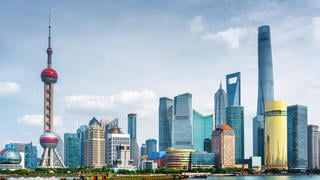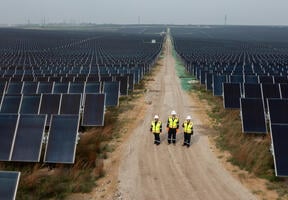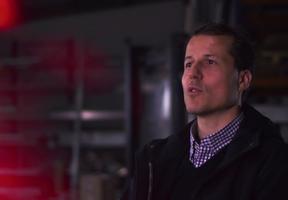Shanghai, the Showcase for China's New Environmental Policy
10 min read
The great metropolis of Shanghai, a symbol of China's exponential growth and openness to the world, has become both a testing ground and a showcase for the country's ongoing efforts to reduce air pollution and control urbanization.

© Thinkstock - Shanghai now has one of the most famous skylines in the world, rivaling Manhattan in New York.
Shanghai's development has been shaped by the changing trends in centralized Chinese policy.
- After acting as a gateway for Western influence from the late 19th century, Shanghai was closed to the outside world following the 1950 rise of Mao Zedong, when the Beijing-based communist regime deliberately sought to curb the city's development.
- From 1980 onward, Deng Xiaoping's market-economy reforms fueled spectacular growth, helping Shanghai to regain its influence among the central government in Beijing and starting a new page in the city's history. Shanghai's port reclaimed its international status thanks to its location at the mouth of the Yangtze River, which runs right through China, and is now the world's busiest container port, ahead of Singapore. Shanghai also emerged as China's financial hub, rivaling Hong Kong.
- Economic liberalization triggered large-scale rural flight, which saw more than 500 million people converging on China's cities. Shanghai's population rose from 6 million in 1980 to nearly 24 million in 2015. Even today, some 300,000 additional people arrive each year.
- In the early 2010s, in response to urban management problems and severe pollution in the country's cities, the Chinese authorities shifted their policy focus from growth alone to . As the host of the 2010 World’s Fair, Shanghai was given the task of showcasing this new "eco‑friendly" policy. It is difficult to assess and quantify the actual impact of this change in strategy, however, because decision-making in China is still highly centralized and often opaque, in contrast with other major world cities, which have introduced new, extremely transparent forms of governance.
Shanghai Tower, Energy Efficient by Design
Starting in 1993, Shanghai developed a new business district in Pudong based on a high-rise urban development strategy. Swaths of office towers sprung up from the ground in the space of just a few years, together with a new airport, a deep-water port, universities, eco-industrial parks and ultra-modern telecommunications networks – all designed to attract thousands of foreign businesses, particularly tech companies.
Pudong exemplifies the ambiguous relationship between China's new-found desire for and its long-standing pride in its growth, as seen in the city's brightly-lit, ad‑covered buildings and infrastructure. Inaugurated in September 2015 and second only to Dubai's 828-meter Burj Khalifa in height, the 632-meter Shanghai Tower is a symbol of both urban gigantism and ecological innovation. The tower features a "double-skin" façade, with one layer of glass enclosing the offices and retail spaces and a second, twisting layer forming the building's exterior. The void between the two contains landscaped atriums that act as a thermal buffer, benefiting from the cool air provided by the central air-conditioning system during the summer and the warm air during the winter chill. The building also has dozens of vertically-aligned wind turbines at altitudes of 500 meters and above and is topped off by a spiral-shaped parapet that collects rainwater for use in the air‑conditioning system.
Curbing Pollution, Easing Gridlock
China's fast-paced industrialization exacerbated pollution in Shanghai as in the rest of the country, while rising household incomes led the number of vehicles on the road to soar. The first policy response was to relocate polluting companies. In the summer of 2016, 153 emissions-intensive industrial sites around Shanghai’s Disneyland were closed down for the park's opening. At the same time, the government introduced more stringent standards and began building eco-industrial parks, such as the Shanghai Chemical Industry Park (SCIP), some 40 kilometers from the city center.
The second response was to significantly step up public transportation, primarily with the Shanghai Metro. Specially designed for continuous expansion, the Shanghai Metro started with four lines in 1993 and now stretches 600 kilometers and serves 350 stations. It is scheduled to grow to 800 kilometers and 500 stations by 2020, which will make it the longest network in the world. Its purpose is to connect the city center with the many satellite cities and industrial areas that have sprung up to accommodate migrants from rural areas. Alongside the metro, Shanghai has also introduced electric and gas‑powered buses. And, in keeping with its role as showcase, the city has installed a high-speed Maglev train that uses magnetic levitation to move without touching the rails, enabling it to make the 30-kilometer trip from Pudong International Airport to the Lujiazui business district in just seven minutes.
Encouraging the Use of Electric Vehicles
Electric vehicles are officially encouraged throughout China, and Shanghai is no exception. Motorists who opt for an electric vehicle are not required to pay for a license plate, meaning they can avoid the unusual auctions that other would-be vehicle buyers must submit to – and the price tag of up to $10,000 that often go with them. The city also has a subsidy program that can, for example, bring down the price of the BYD, the most popular electric car, from $45,000 to around $32,000.
While the electric car market is still in the early stages of development, the market for electric scooters and bicycles is booming. It has become quite common to see them gliding silently through the streets of Shanghai's new towns or down the lilongs, the historic lanes of its few remaining traditional neighborhoods.















